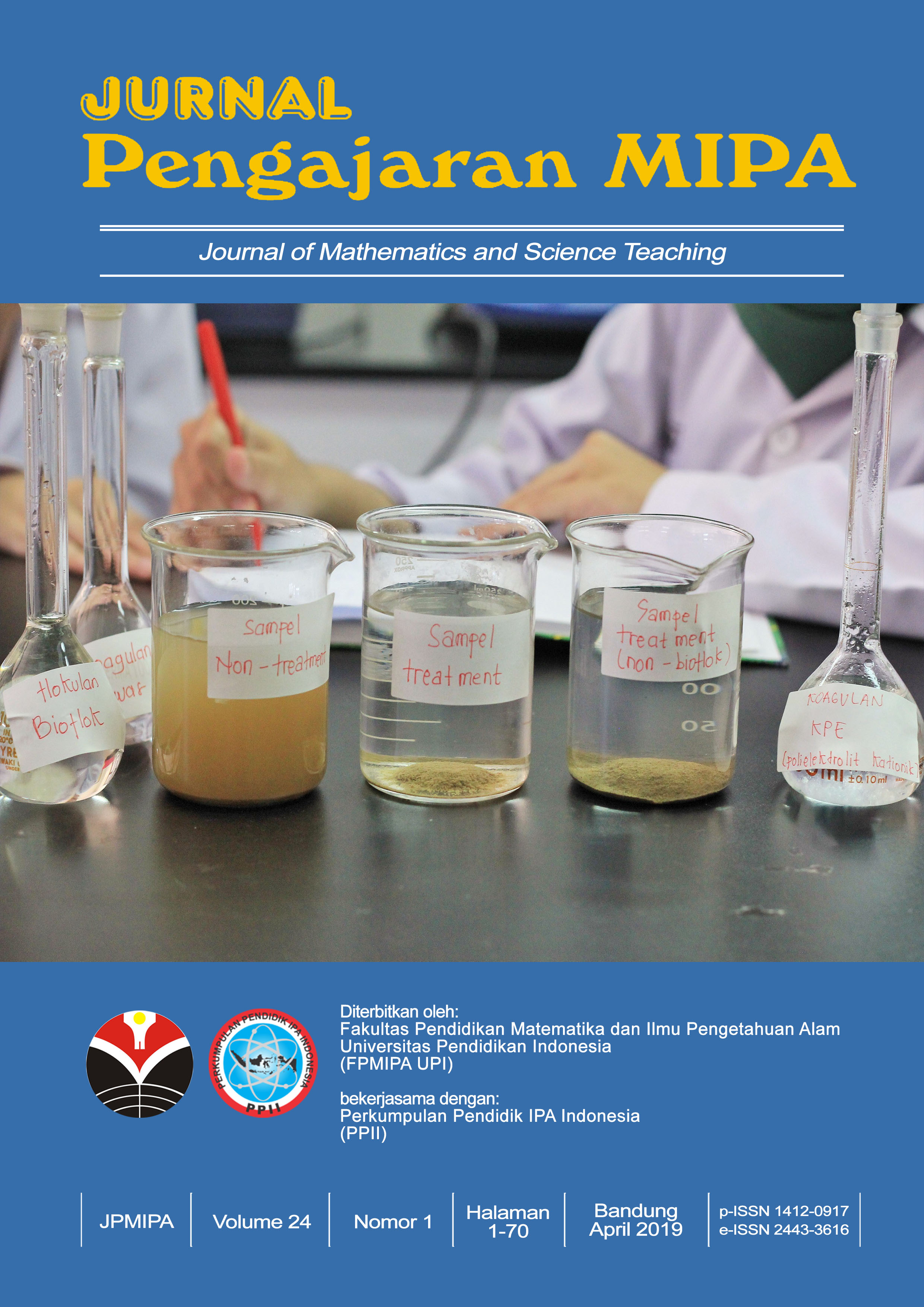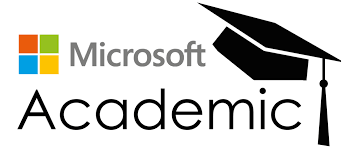STRATEGI PEMBELAJARAN CREATIVE PROBLEM SOLVING (CPS) BERBASIS EKSPERIMEN UNTUK MENINGKATKAN KEMAMPUAN KOGNITIF DAN KETERAMPILAN BERPIKIR KREATIF
Abstract
ABSTRAK
Penelitian ini bertujuan untuk mendapatkan gambaran terkait peningkatan kemampuan kognitif dan keterampilan berpikir kreatif dalam pemecahan masalah siswa setelah diberikan perlakuan dengan pembelajaran CPS berbasis eksperimen dan pembelajaran kovensional. Metode yang digunakan dalam penelitian ini adalah metode kuasi eksperimen dengan desain the randomized pretest-posttest control group design. Sampel penelitian sebanyak 58 siswa SMA yang dibagi ke dalam dua kelas (29 kelas eksperimen dan 29 kelas kontrol). Data yang terkumpul kemudian dianalisis dengan menggunakan perhitungan N-gain, Uji-t, dan perhitungan effect size. Hasil analisis data menunjukkan bahwa kemampuan kognitif siswa untuk kedua kelas sama-sama mengalami peningkatan dengan kategori sedang. Untuk keterampilan berpikir kreatif dalam pemecahan masalah siswa, kelas eksperimen mengalami peningkatan dengan ketegori sedang sedangkan kelas kontrol meningkat dengan kategori rendah. Berdasarkan hasil uji hipotesis menunjukkan bahwa penerapan pembelajaran CPS berbasis eksperimen secara signifikan dapat lebih meningkatkan kemampuan kognitif dan keterampilan berpikir kreatif dalam pemecahan masalah siswa dibanding penerapan pembelajaran konvensional. Selain itu, berdasarkan hasil perhitungan effect size menunjukkan bahwa penerapan pembelajaran CPS berbasis eksperimen efektif dalam meningkatkan kemampuan kognitif dan keterampilan berpikir kreatif dalam pemecahan masalah siswa dengan kategori sedang.
ABSTRACT
This study aimed to get an idea related to the development of cognitive abilities and creative thinking skills in problem solving student after being given treatment with CPS-based experimental learning and conventional learning. The method used in this research is a quasi-experimental design with the randomized pretest-posttest control group design. The research sample group of 58 high school students who are divided into two classes (class 29 experimental and 29 control group). The collected data was then analyzed using N-gain calculation, t-test, and the calculation of effect size. The result showed that the students' cognitive abilities for both classes equally increased by the moderate category. For the creative thinking skills of students in problem solving, experimental class increased by categories was increased while the control class with low category. Based on the test results show that the application of learning hypothesis-based experiments CPS can significantly improve the cognitive abilities and skills of creative thinking in solving problems of students compared to the application of conventional learning. In addition, based on the calculation of effect size indicates that the application of experiment-based learning CPS effective in improving cognitive ability and creative thinking skills in problem solving students with moderate category.
Keywords
Full Text:
PDFReferences
Anderson, Lorin, W. dan David R. K. (2010). Kerangka Landasan untuk Pembelajaran, Pengajaran dan Assessmen. Yogyakarta: Pustaka Belajar.
Bilal, A. A. (2012). The effect of using brainstorming strategy in developing creative problem solving skills among female students in princess alia university college. American International Journal of Contemporary Research Vol. 2 No.10, hlm. 29-38.
Bwli, Q. (2006). The effectiveness of using brainstorming strategy in developing creative thinking in Islamic Education among Third secondary students in Tabouk City. Master Thesis. Mut’a University. Jordan.
Brookhart, S. M. (2010). How to Assess Higher-Oder Thingking Skill in Your Classroom. Alexandria: Virginia USA.
Centikaya, C. (2013). The effect of gifted students’ creative problem solving program on creative thinking. Procedia Social and Behavioral Sciences Vol. 116 No.1, hlm. 3722 – 3726.
Chandra, D. T. (2010). Kajian efektivitas pembelajaran fisika dalam meningkatkan technological literacy dan kreativitas siswa SMP Melalui implementasi program pendidikan teknologi dasar (PTD). Jurnal Berkala Vol. 13 No.2, hlm. E15-E24.
Clegg, B. dan Brich, P. (2006). Instan Creativity: 76 Cara Instan Meningkatkan Kreativitas. Jakarta: Erlangga.
Cohen, J. (1988). Statistical Power Analysis for the Behavioral Sciences, Second Edition. New Jersery, USA: Lawrence Erlbaum Associates.
Depdiknas (2008). Strategi Pembelajaran dan Pemilihannya. Jakarta: Depdiknas.
Frankel, J. R., Wallen, N. E. Hyun dan Hellen, H. (2012). How to Design and Evaluate Research in Education. New York: McGraw-Hill.
Hadzigeorgiou, Y., Fokialis, P. dan Kabouropoulou, M. (2012). Thinking about creativity in science education. Scientific Research Vol. 3 No.5, hlm. 603-611.
Hake, R. R. (1999). analyzing change/gain scores. American Educational Research Association. [online] tersedia di: http://www.physics.indiana.edu/~sdi/ AnalyzingChange-Gain.pdf.
Helie, S. dan Sun, R. (2010). incubation, insight, and creative problem solving: a unified theory and a connectionist model. American Psychological Association Vol. 117 No.3, hlm. 994–1024.
Isaksen, S. G. (1995). on the conceptual foundations of creative problem solving. a response to magyary beck. Creative of Inovation Managemen Vol. 4 No.1, hlm. 1628–1635.
Isaksen, S. G. (2007). An exploratory studi of the relationships between an assessment of problem solving style and creative problem solving. The Korean Journal of Thingking & Problem Solving Vol. 17 No.1, hlm. 5–26.
Kandemir, M. A. dan dan Gur, H. (2009). The use of creative problem solving scenarios in mathematics education: views of some prospective teachers. Procedia- Social and Behavioral Sciences Vol. 1 No.1, hlm. 53–63.
Kusuma, Y. (2010). Creative Problem Solving. Tanggerang: Rumah Pengetahuan.
Leisema, S. dan Wannapiron, P. (2013). Design of collaborative learning with creative problem-solving process learning activities in a ubiquitous learning environment to develop creative thinking skills. Procedia Social and Behavioral Sciences Vol. 116 No.14, hlm. 3921 – 3926.
Michalko, M. (2012). Pemikiran Pemikir Kreatif. Jakarta: PT. Indeks.
Munandar, U. (2004). Pengembangan Kreativitas Anak Berbakat. Jakarta: Rineka Cipta.
Pehkonen, E. dan Helsinki (1997). The state-of-art in mathematical creativity. International Reviews on Mathematical Education Vol. 29 No.3, hlm. 63-67.
Sanjaya, W. (2006). Strategi Pembelajaran. Berorientasi Standar Proses Pendidikan. Jakarta: Kencana.
Treffinger, D. J. et al. (2002). Assessing Creativity: A Guide for Educators. Florida: Center for Creative Learning Sarasota.
Treffinger, J. T., Isaksen, S. G. dan Dorval, B. S. (2006). Creative problem Solving. Texas: Prufrock Press Inc.
Wang, C. W. dan Horng, R. Y. (2002). The effects of creative problem solving training on creativity, cognitive type and R & D performance. The Journal of Research, Technology and Innovation Management, Vol. 32 No.1, hlm. 35-45.
Wang, H. C., Li, T.Y. dan Chang, C. Y. (2005). A user modeling framework for exploring creative problem-solving ability. Proceedings of AIED Conference, Amsterdam, The Netherlands.
DOI: https://doi.org/10.18269/jpmipa.v20i2.36234
Refbacks
- There are currently no refbacks.
Copyright (c) 2021 Jurnal Pengajaran MIPA

This work is licensed under a Creative Commons Attribution-ShareAlike 4.0 International License.
JPMIPA http://ejournal.upi.edu/index.php/jpmipa/index is licensed under a Creative Commons Attribution-ShareAlike 4.0 International License
Jurnal Pengajaran Matematika dan Ilmu Pengetahuan Alam (JPMIPA) or Journal of Mathematics and Science Teaching
All rights reserverd. pISSN 1412-0917 eISSN 2443-3616
Copyright © Faculty of Mathematics and Science Education (FPMIPA) Universitas Pendidikan Indonesia (UPI)
179,454 View JPMIPA Stats









